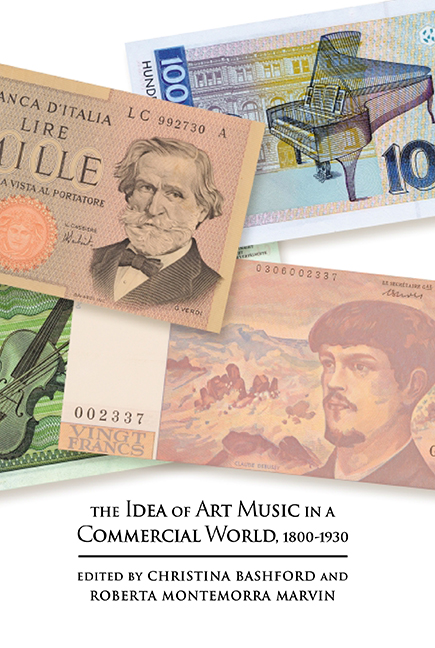Book contents
- Frontmatter
- Contents
- List of Figures
- List of Tables
- Notes on Contributors
- Acknowledgements
- A Note on Translations
- Bibliographic Abbreviations
- Introduction: The Idea of Art Music in a Commercial World
- PART I PUBLISHERS
- PART II PERSONALITIES
- PART III INSTRUMENTS
- PART IV REPERTOIRES
- PART V SETTINGS
- Index
- Music in Society and Culture
1 - Selling ‘Celebrity’: The Role of the Dedication in Marketing Piano Arrangements of Rossini’s Military Marches
Published online by Cambridge University Press: 27 May 2021
- Frontmatter
- Contents
- List of Figures
- List of Tables
- Notes on Contributors
- Acknowledgements
- A Note on Translations
- Bibliographic Abbreviations
- Introduction: The Idea of Art Music in a Commercial World
- PART I PUBLISHERS
- PART II PERSONALITIES
- PART III INSTRUMENTS
- PART IV REPERTOIRES
- PART V SETTINGS
- Index
- Music in Society and Culture
Summary
BY the mid nineteenth century, every European household that could boast knowledge of culture owned a piano. Purposefully placed in the salons and parlours that were sites of ritual evening musicales, these instruments created an artistic environment that Thomas Christensen has described as ‘bourgeois banality’. Dedicated domestic dilettantes and their audiences quickly wearied of repeated repertoire, whether solo renditions or four-hand duets, and created a classic case of economic ‘demand’. Music publishers were only too willing to comply, generating a stream of sheet music for piano in much the same way that internet music services in the early twenty-first century inundate their markets with downloads.
At the centre of a network that included composers at one end of the production process and shop owners at the other, publishers explored approaches to increase their catalogue offerings and to promote sales. The surest strategy was to feature music that consumers had actually heard, or at the very least that they had heard of. Some of the most popular piano arrangements were excerpts from famous symphonic works and, pandering to the public's desire to be au courant, from the latest operas. Advertisements in sales catalogues and editorial puffery in publisher-owned journals heralded these new pieces, often by composers of international repute but also by well-known (but now-forgotten) local and regional personalities.
Publishers also resorted to less transparent measures that extended beyond an appeal to their customers’ musical taste and acumen. As businessmen, they acknowledged that sheet music was a ‘product’ that required ‘packaging’, so effort went into its design, particularly of the first page that would attract a buyer – the cover. Some frontispieces bore engravings, often as elaborate or colourful as the artwork hanging in one's home. Strategically left unopened on the piano, these richly decorative pieces graced both the instrument and the room in which it sat. Even covers without images could entice the eye with ornamented text set in varied fonts, types and letter cases. Beyond visual elements, sheetmusic covers might also display something with powerful subliminal appeal: a ‘celebrity’ dedication. Appearing within or near the title, such declarations either stated outright or at least implied that the very music that customers held in their hands had been written expressly for a noble or person of elevated social status; possessing a copy was proof that its owner was among the cognoscenti.
- Type
- Chapter
- Information
- The Idea of Art Music in a Commercial World, 1800-1930 , pp. 18 - 38Publisher: Boydell & BrewerPrint publication year: 2016



